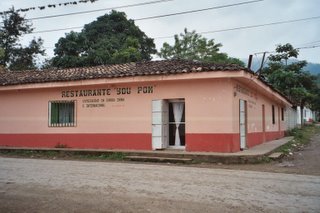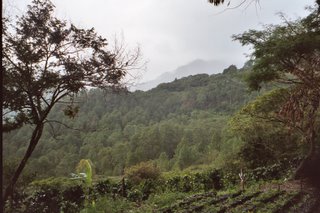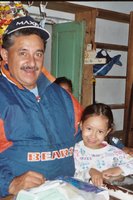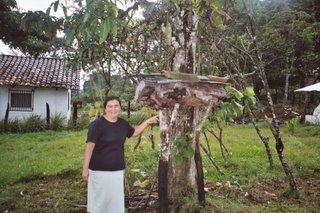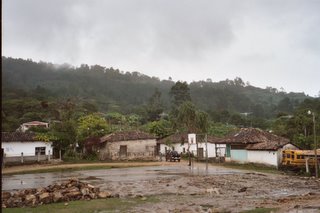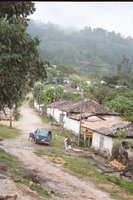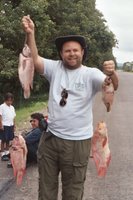I’ve been working hard lately, so I took some comp time yesterday morning to make one last canoe trip for 2005—I did it solo in weather that was just above the freezing mark. In a month, this river and all others in this region will be iced over. To some, this might not sound appealing, but to me it was a taste of heaven. I saw no one, not even in the park where I took out. I was alone in my boat, watching nature and enjoying the elements. I hope you enjoy my brief remembrance of the trip.
---
The tempered-gray sky spits sleet as I slid my canoe into the water below McKeow’s Bridge. It’s barely above freezing. Crawling into the boat, I position myself on my knees, just behind the middle point, and use the paddle to push off. The boat is positioned up river, at an angle, so that the current catches the bow and quickly spins me into the channel, pointing down river. I dig the paddle into the water, with a hook on the end to keep it straight, and take off toward town, eight miles away. A few hundred yards downstream, a great blue heron rises up from the its perch, its large wing-span and long-bent neck looking like left-over traits from some prehistoric age. The bird glides down river, as if a guide. He occasionally stops at a log along the blank, allowing me to nearly catch up, only to take off again in flight as I approach. This occurs over and over again, until finally, a good distance down stream, at a point where the river is wide, he turns and on the far side, flies up river toward his home, staying clear of my canoe. A short while later another heron takes over and leads me further down river.
The sleet picks up and pelts my face. Attempting to read the river, I squint, looking for V’s facing down river. Coming around a bend, the wind suddenly blows against me. The water is deeper and there is no current. I shiver and dig my paddle deeper in order to make headway. Soon, the water is shallower and faster, gurgling over rocks, as it pulls the boat quickly downstream. Another bend and the wind abates, but not for long. As with the herons, the cycle repeats itself over and over.
The trees along the bottomland are bare, hibernating for winter. A few isolated pines and an occasional patch of moss provide the only greenery. On tree branches, I watch the few birds sticking it out in winter: a few flickers, some small songbirds, a cardinal. In the distance I hear the call of a crow. A few squirrels run up and down trees, their summer nest still preciously perched near the top of the trees. At one point, I am surprised looking at a tree recently split during a storm, to see a squirrel pokes it’s head out of a the hollow middle. Seeing me, he ducks back inside, not wanting to give out the location of his new home, I’m sure. In the bare forest, I even spot a few abandoned hornet nests.
I stay warm by working hard, but sitting in the bottom of the boat, my feet freeze. After tiring, I spot an eddy down stream and maneuver the boat so that the current pulls me into the calm waters. I pour a cup of tea from a thermos and sit for a few minutes, enjoying the warmth of the liquid as I make a few notes in my journal. Sitting is too cold, so I push the bow back into the stream and allow it to pull the boat out into the current and continue on downstream. The swampland gives away to higher banks. When I get in sight of the railroad trestle for the long abandoned C, K & S, near the site of the old foundry, the hardwood bottomland gives way to industry. There are still a few factories here in operation. I quickly pass under the trestle and under a couple other bridges, before coming to the landing at Tyden Park. I spot my truck, sitting alone in the parking lot. A few minutes later, I’ve load my canoe and head home in time for lunch.
---
The tempered-gray sky spits sleet as I slid my canoe into the water below McKeow’s Bridge. It’s barely above freezing. Crawling into the boat, I position myself on my knees, just behind the middle point, and use the paddle to push off. The boat is positioned up river, at an angle, so that the current catches the bow and quickly spins me into the channel, pointing down river. I dig the paddle into the water, with a hook on the end to keep it straight, and take off toward town, eight miles away. A few hundred yards downstream, a great blue heron rises up from the its perch, its large wing-span and long-bent neck looking like left-over traits from some prehistoric age. The bird glides down river, as if a guide. He occasionally stops at a log along the blank, allowing me to nearly catch up, only to take off again in flight as I approach. This occurs over and over again, until finally, a good distance down stream, at a point where the river is wide, he turns and on the far side, flies up river toward his home, staying clear of my canoe. A short while later another heron takes over and leads me further down river.
The sleet picks up and pelts my face. Attempting to read the river, I squint, looking for V’s facing down river. Coming around a bend, the wind suddenly blows against me. The water is deeper and there is no current. I shiver and dig my paddle deeper in order to make headway. Soon, the water is shallower and faster, gurgling over rocks, as it pulls the boat quickly downstream. Another bend and the wind abates, but not for long. As with the herons, the cycle repeats itself over and over.
The trees along the bottomland are bare, hibernating for winter. A few isolated pines and an occasional patch of moss provide the only greenery. On tree branches, I watch the few birds sticking it out in winter: a few flickers, some small songbirds, a cardinal. In the distance I hear the call of a crow. A few squirrels run up and down trees, their summer nest still preciously perched near the top of the trees. At one point, I am surprised looking at a tree recently split during a storm, to see a squirrel pokes it’s head out of a the hollow middle. Seeing me, he ducks back inside, not wanting to give out the location of his new home, I’m sure. In the bare forest, I even spot a few abandoned hornet nests.
I stay warm by working hard, but sitting in the bottom of the boat, my feet freeze. After tiring, I spot an eddy down stream and maneuver the boat so that the current pulls me into the calm waters. I pour a cup of tea from a thermos and sit for a few minutes, enjoying the warmth of the liquid as I make a few notes in my journal. Sitting is too cold, so I push the bow back into the stream and allow it to pull the boat out into the current and continue on downstream. The swampland gives away to higher banks. When I get in sight of the railroad trestle for the long abandoned C, K & S, near the site of the old foundry, the hardwood bottomland gives way to industry. There are still a few factories here in operation. I quickly pass under the trestle and under a couple other bridges, before coming to the landing at Tyden Park. I spot my truck, sitting alone in the parking lot. A few minutes later, I’ve load my canoe and head home in time for lunch.

